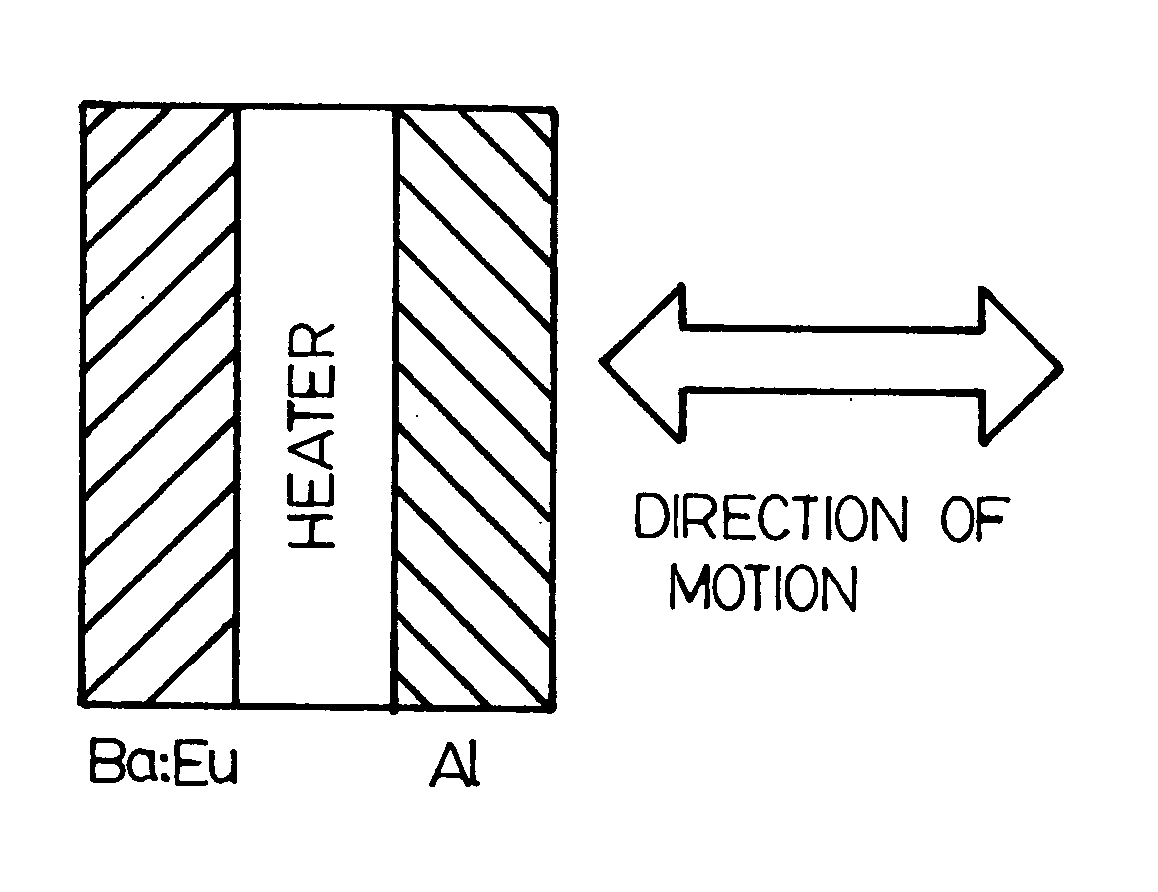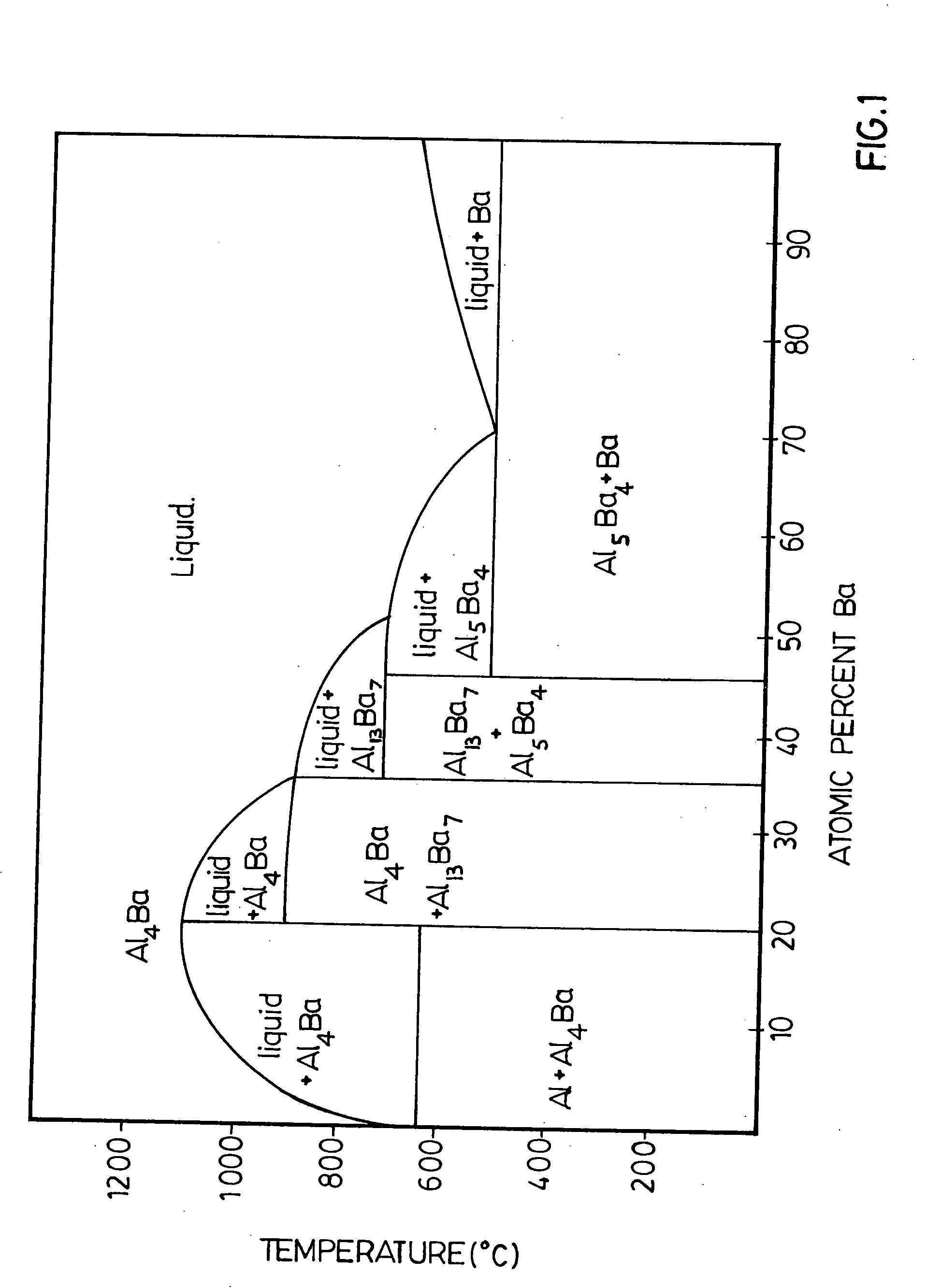Reactive metal sources and deposition method for thioaluminate phosphors
a thioaluminate and phosphor technology, applied in the field of phosphor deposition, can solve the problems of loss of luminance and energy efficiency, difficult control of stoichiometry of phosphor films, and relatively poor luminosity and stability, so as to improve the luminance and emission spectrum, reduce the degree of control, and achieve high, yet uniform luminosity
- Summary
- Abstract
- Description
- Claims
- Application Information
AI Technical Summary
Benefits of technology
Problems solved by technology
Method used
Image
Examples
example 1
[0045] A cylindrical barium aluminum sputtering target of diameter 7.6 cm and thickness of 6 mm with a composition of 47.5 atomic percent barium, 47.5 atomic percent aluminum and 5 atomic percent europium was prepared (ACl Alloys of San Jose, Calif.). The target was used in an Edwards model FL400 rf magnetron sputtering system as the sole source of barium, aluminum and europium to reactively sputter a europium doped thioaluminate film under a gas pressure of 0.2 to 0.5 Pascals.
[0046] Several electroluminescent devices were fabricated with phosphor films deposited using the sputtering system described above. The sputtering process gas was an argon hydrogen sulfide mixture introduced into the sputtering chamber during film deposition with the ratio of argon to hydrogen sulfide in the gas mixture ranging from 1:1 to 4:1. The rf power applied to the sputtering target for the depositions was 200 watts.
[0047] The deposition substrates were 5 cm by 5 cm glass substrates similar to those ...
example 2
[0050] Electroluminescent devices similar to those of example 1 were prepared, except that the target composition for phosphor deposition was 17 atomic percent barium, 81 atomic percent aluminum and 2 atomic percent europium. These devices did exhibit electroluminescence under the test conditions of example 1. The concentration of elements in the deposited phosphor films as measured by energy dispersive x-ray analysis (EDX) on films deposited on silicon wafers placed immediately adjacent to the EL device substrates as a function of the ratio of argon to hydrogen sulfide in the process gas for phosphor sputtering is shown in FIG. 2. A complete chemical analysis of the phosphor films, also measured using EDX on films deposited on silicon wafers, is shown for several devices incorporating thick film dielectric layers in Table 1. Table 1 also shows threshold voltage and the luminance and the CIE y colour co-ordinates of the devices measured at 60 volts above the threshold voltage, measu...
example 3
[0052] An electroluminescent device similar to that of example 1 was prepared, except that it had a 50 nm thick layer of barium tantalate between the thick film dielectric layer and the phosphor layer. Furthermore, the phosphor was deposited by thermal evaporation in a Dynavac box coater using a thermal source for barium and europium consisting of pellets of metallic barium of approximate dimension 2 to 5 mm that were alloyed with 6 atomic percent of europium and a second thermal source pellet consisting of pieces of aluminum sulfide of approximate dimension 2 to 10 mm. Prior to deposition, the deposition chamber was pumped down to a base pressure of 7×10−3 Pa. Supplementary sulfur was provided in the deposition chamber by the injection of hydrogen sulfide at a rate of 150 sccm to maintain a working pressure of 3×10−2 Pa during the deposition process. The barium source pellet was heated to melt these source materials.
[0053] The deposition chamber was fitted with a nitrogen cold tra...
PUM
| Property | Measurement | Unit |
|---|---|---|
| humidity | aaaaa | aaaaa |
| thickness | aaaaa | aaaaa |
| rf power | aaaaa | aaaaa |
Abstract
Description
Claims
Application Information
 Login to View More
Login to View More - R&D
- Intellectual Property
- Life Sciences
- Materials
- Tech Scout
- Unparalleled Data Quality
- Higher Quality Content
- 60% Fewer Hallucinations
Browse by: Latest US Patents, China's latest patents, Technical Efficacy Thesaurus, Application Domain, Technology Topic, Popular Technical Reports.
© 2025 PatSnap. All rights reserved.Legal|Privacy policy|Modern Slavery Act Transparency Statement|Sitemap|About US| Contact US: help@patsnap.com



